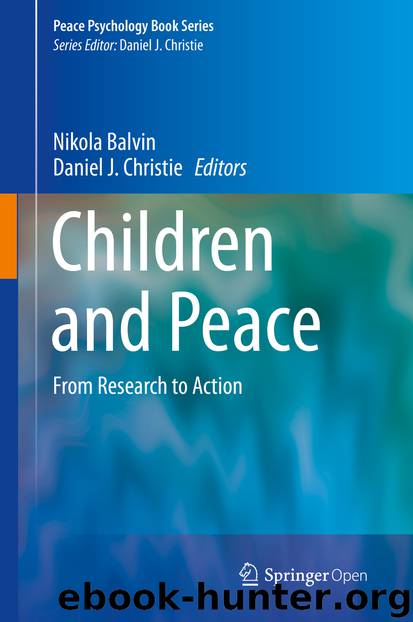Children and Peace by Unknown

Author:Unknown
Language: eng
Format: epub
ISBN: 9783030221768
Publisher: Springer International Publishing
11.1 The Need of Young Generations to Learn About Their In-Group past
Often at times, the idea that young people are indifferent to history and are only embedded in present days is presented as common sense. On the contrary, many important classic studies have shown that learning about their in-group’s historical past is a basic socio-psychological need for young people coming of age and starting to cope with their adult responsibilities in the democratic forum.1
A first and fundamental example on the precious contribution of history to enhance the full development of democratic societies is offered by the classic book The Historian’s Craft or Apology of History (Bloch, 1954). Bloch wrote this unfinished masterpiece referring only to his own memory, shortly before being executed in 1944 as a leader of the French resistance. Bloch chose to build the whole of his little but classic book around a hypothetical question posed by his 12-year-old son after the sudden shock following the conquest of Paris by the Nazi troops: “What is the use of history?” Using this literary fiction, Bloch explained to his son that the function of historical accounts is not to provide advice or strategic counselling in dangerous times, but to comply with a basic law of the human mind, namely, to fulfil its “instinctive need of understanding”. Especially in dark historical times, in the intimacy of their communications, families participate in a never-ending collective effort to give meaning to the historical events they have to face. Without taking into account this activity of human mind, it is impossible to understand the impact of historical facts on society. The recounting of history helps individuals assign meaning to what happened in the past and sets the stage for how they choose to conduct their lives going forward (Sweeny, 1993).
In these same dark years, another influential French scholar, Maurice Halbwachs, focused his attention on family narratives of the past. Halbwachs (1925/1992) decided to observe what happens when family members gather together to remember (“quand la famille se souvient”). He noted how, in the intimate setting of their face-to-face conversations, families repeatedly narrated some specific episodes, chosen from among several that had occurred in the family’s past. Sometimes, shared memories would recollect specific historical events. At other times, these family narratives would convey to younger members recollections of past ways of living that had been experienced by the older generations but were subsequently gone. Although knowing them by heart, family members listened with evident pleasure to these over-narrated episodes and seemed to cherish them as a kind of family treasure. By contrast, these same memories were not shared with strangers. In his seminal books, Halbwachs (1925/1992, 1950/1980) proposed that repeated family memories supported the personal positive identity of younger generations. By repeatedly sharing family memories that were not told to strangers, families were gifting to their younger members a positive image of the nucleus from which they originated and therefore of the fabric of which all of the family members were made – an “emotional
Download
This site does not store any files on its server. We only index and link to content provided by other sites. Please contact the content providers to delete copyright contents if any and email us, we'll remove relevant links or contents immediately.
Kathy Andrews Collection by Kathy Andrews(11726)
The remains of the day by Kazuo Ishiguro(8817)
Paper Towns by Green John(5087)
Spare by Prince Harry The Duke of Sussex(5072)
The Body: A Guide for Occupants by Bill Bryson(4973)
Industrial Automation from Scratch: A hands-on guide to using sensors, actuators, PLCs, HMIs, and SCADA to automate industrial processes by Olushola Akande(4970)
Machine Learning at Scale with H2O by Gregory Keys | David Whiting(4170)
Be in a Treehouse by Pete Nelson(3942)
Never by Ken Follett(3787)
Harry Potter and the Goblet Of Fire by J.K. Rowling(3772)
Goodbye Paradise(3724)
Into Thin Air by Jon Krakauer(3308)
The Remains of the Day by Kazuo Ishiguro(3293)
The Cellar by Natasha Preston(3259)
The Genius of Japanese Carpentry by Azby Brown(3223)
Fairy Tale by Stephen King(3216)
120 Days of Sodom by Marquis de Sade(3177)
Drawing Shortcuts: Developing Quick Drawing Skills Using Today's Technology by Leggitt Jim(2996)
The Man Who Died Twice by Richard Osman(2995)
